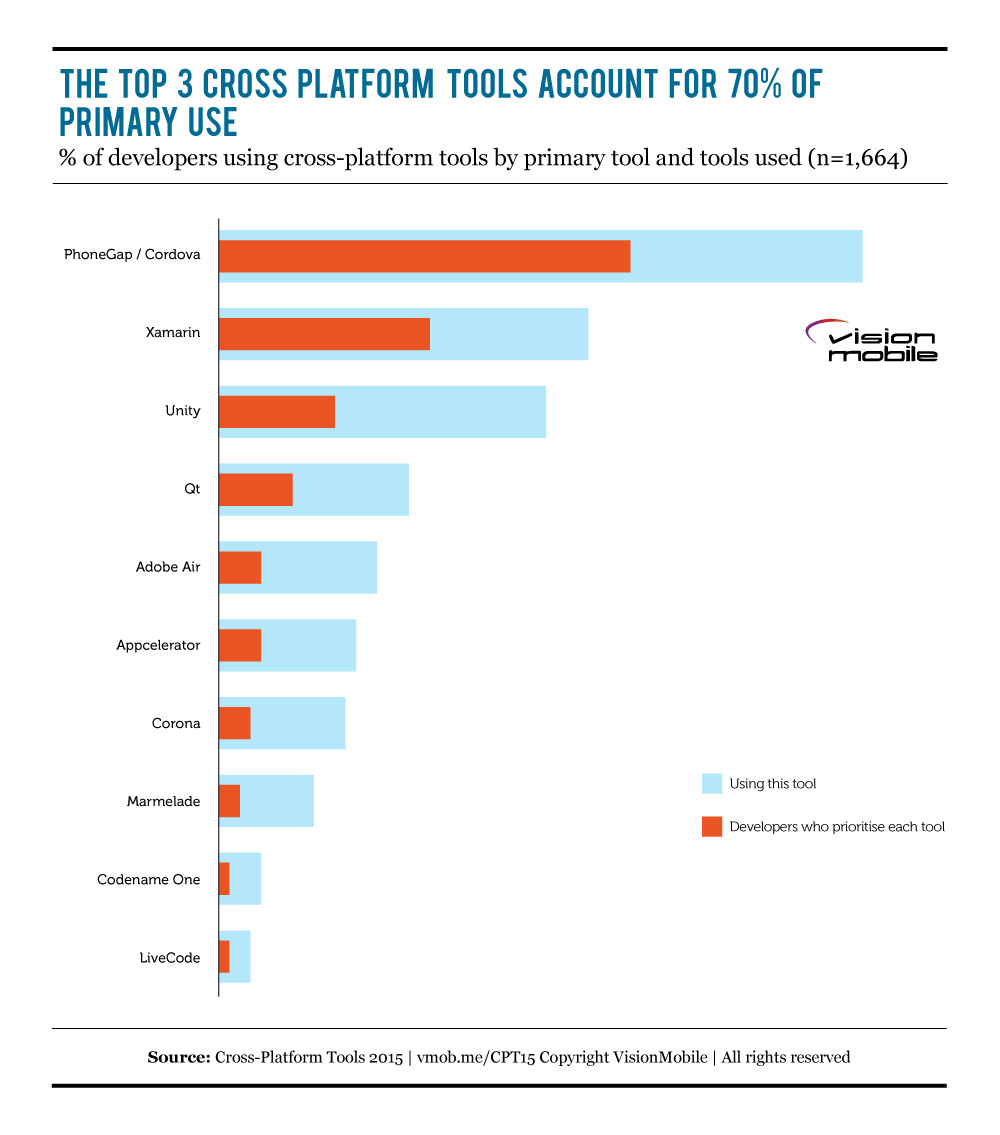The real reasons for the growing popularity of PhoneGap and other cross-platform development tools

Cross-platform development tools like PhoneGap and Xamarin are more popular than ever. It's good. True, the reasons for such popularity lie in no way in the desire of the developer to create a high-quality application that the user would like. In fact, the reasons are somewhat different.
According to a new study by Visionmobile, based on a survey of 8,000 developers, 30% of all developers who create mobile applications use cross-platform tools. But this is caused by the desire of the developer to save his time and money, and not by improving user interaction.
This approach does not help to get to the App Store tops (by the way, in the Appodeal blog, we already talked about how to optimize our presence in the Google Play and App Store catalogs). As a result, more and more poor-quality applications created using cross-platform tools appear.
')
Three leaders
The most popular today are three products - the main competitors in the market for cross-platform development tools. This PhoneGap (also called Apache Callback, based on Apache Cordova) is a free open-source mobile application creation framework created by Nitobi Software. Allows you to create applications for mobile devices using JavaScript, HTML5 and CSS3 without the knowledge of "native" programming languages (for example, Objective-C) for all mobile operating systems (iOS, Android, Bada, etc.). The finished application is compiled as installation packages for each mobile operating system.
On the second and third places are located, respectively, Xamarin and Unity.

In just three years, the market structure of cross-platform development tools has changed a lot. So, in 2012, the market was saturated with a large number of different tools. But the same year became the point of bifurcation, when several tools stood out from the whole variety of systems, which occupied most of the market, and the share of all other tools began to decline.
In 2012, PhoneGap and other Apache Cordova-based tools accounted for about 30% of the market. Now this value has doubled. Xamarin has become the most popular among Windows developers, the development of the platform took about three years. And Unify has become popular in game development.

Such consolidation is undoubtedly an excellent development option for the development market, when a certain tool is used by a certain audience. This also leads to the acceleration of innovative solutions. But here the question arises: for whom is this innovation?
Made by developers for developers
If you examine the data provided by Visionmobile, it becomes clear that cross-platform development tools are becoming more popular, but this happens for reasons that not all would call it desirable:

The fact that developers create universal applications that are compatible with a variety of mobile operating systems, improve their own professional skills, speed up the application development process and all this for little money is great. But it is not clear here what the benefits are for customers or end users of an application created with a cross-platform tool. What do users or customers get in the end? Yes, everything is the same as before, no significant improvement in the quality of applications occurs. On the contrary, in pursuit of speed and cheapening the creation of the program, some developers are paying less and less attention to the end user.
Of course, it also depends on the interpretation of the term “customer”. For corporate application creators, the customer is an IT director. For developers of corporate applications, the primary task is to reduce costs, while the user experience with such an application is not at all important. Freelance developers (39% use CPT) and corporate developers (29% use CPT), which interact with such corporate customers, pay little attention to the user, and sometimes do not care about it at all.
The second major category of cross-platform tool users is digital content publishers. For them, the usability of the application by the end user is more important.
But not only news media and other publishers of digital content should be interested in ensuring that the application is of high quality, interesting and useful for the end user of such a product. The recipe is simple: work on your application carefully, paying attention to all aspects of the use of the program by the target audience.
As output
The quality of the created application depends primarily on the developer, and not on the development tool, be it JavaScript frameworks or AngularJS.
Perhaps the poor quality of applications created with cross-platform tools is due to the simplicity of these tools.
One of the developers who uses Cordova, commented on this situation: “In any category there are good or bad applications. But Apache Cordova lowers the bar, so we see a large number of bad applications, according to the rule of Sturgeon (the interpretation of this rule says that 90% of all is garbage). This is the price to be the most popular solution. ”

By the way, React Native, a project promoted by Facebook, can become another promising tool for cross-platform development. This tool is also known as ReactJS. Perhaps this platform will become one of the market leaders, because there is a lot of what the developer needs.
But no matter how convenient the tool is, you need to remember that applications are developed for users, not developers. Therefore, when working with any cross-platform tool, this rule should be taken into account.
We at Appodeal from the first day of the company’s existence try to cover as many different frameworks as possible. Already today we support Unity, Cocos2d-x, Marmalade, PhoneGap, Gideros, Adobe Air, B4A, Cordova, Xamarine and Game Maker and the list is constantly growing. Our task is to make monetization simple and accessible, regardless of the chosen platform.
Source: https://habr.com/ru/post/265689/
All Articles